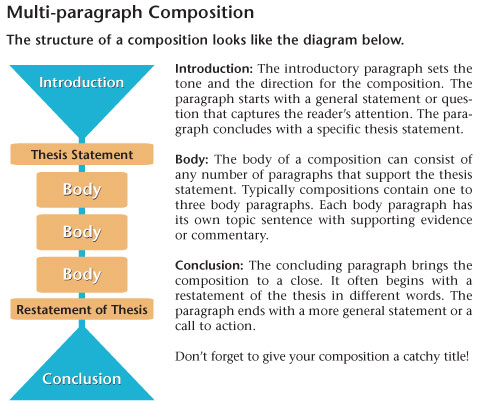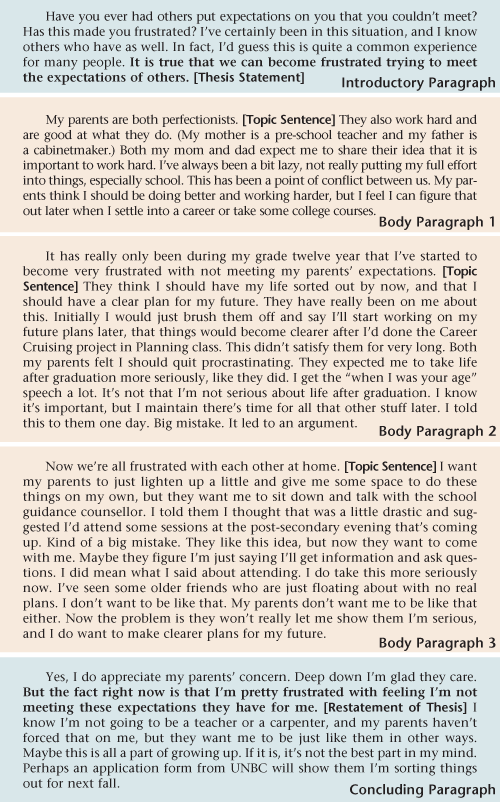Lesson 2.2D: What is Your Story?
 In this lesson, you will write your first multi-paragraph composition (essay) for English 10. This lesson is designed to help you complete Section Assignment 2.2C: Personal Multi-paragraph Composition. Go to the section assignment and familiarize yourself with the instructions before you start this lesson. In this lesson, you will write your first multi-paragraph composition (essay) for English 10. This lesson is designed to help you complete Section Assignment 2.2C: Personal Multi-paragraph Composition. Go to the section assignment and familiarize yourself with the instructions before you start this lesson.
This lesson will walk you through how to develop ideas for a personal multi-paragraph composition, then draft, revise, and write a final copy of it. At various points in this lesson, you will be instructed to complete different parts of your section assignment, so keep your section assignment materials close at hand!
The Personal Multi-paragraph Composition (Essay)
You've just finished reading a novel in which the protagonist or main character had to overcome a significant obstacle.
Now, reflect back on the monologue we read at the beginning of this section, "I'm Not My Brother; I'm Me." It is a good example of a personal multi-paragraph composition. Jonathan tells the story of how he was treated because of his older brothers’ behaviours at school, starting at the beginning of the school year, and ending at winter break when his older brother came home.
Some key features of the personal multi-paragraph composition are that it is written in first person, and it is supported by the writer's own knowledge and experience. In this way a personal composition is not researched: it is about you.
 Open your textbook, Sightlines 10, to page 54, and take another look at "I'm Not My Brother; I'm Me." This time we are going to look at how the multi-paragraph composition is built: we call this multi-paragraph composition structure. Open your textbook, Sightlines 10, to page 54, and take another look at "I'm Not My Brother; I'm Me." This time we are going to look at how the multi-paragraph composition is built: we call this multi-paragraph composition structure. |
The multi-paragraph composition, "I'm Not My Brother; I'm Me," follows a timeline: it seems to take place from the beginning of school until winter break. We can guess this because Jonathan mentions his first day in Mr. Swenson's chemistry class at the beginning of the composition, and talks to his brother about his problems at school when his brother comes home at mid-winder break.
When a composition follows a timeline, with a beginning (start of school), a middle (difficulties with teachers), and an end (talk with brother at winter break), it has a narrative structure, because it is like a story. A personal multi-paragraph composition works well in narrative form because often the composition will tell of something we experienced (or learned from our experience), and the experience will have a beginning, a middle, and an end.
The middle of the composition, "I'm Not My Brother; I'm Me," is developed with examples of Jonathan's teachers' assumptions that he is like his brother, including Mr. Swenson, Miss Scutter, the basketball coach, and the chaperones of the school dance. The paragraphs of this composition are brief, sometimes only two sentences. Each paragraph is about a different topic: usually they are about how Jonathan was treated, or about what he realized from being treated that way.
Looking at the Multi-paragraph Composition Structure
In many respects, the multi-paragraph composition has a similar structure to a paragraph. Look at the following chart:
| Paragraph |
Multi-paragraph Composition |
| Topic Sentence |
Introductory paragraph ending in a thesis statement |
| Body |
Body paragraphs |
| Concluding sentence |
Concluding paragraph |
Paragraph style is more appropriate for simpler ideas that can be developed in five to eight sentences, whereas a multi-paragraph composition is appropriate for more complex ideas that require greater development.
The multi-paragraph compositions (essays) you will write in English 10 will typically be between three to five paragraphs: an introductory paragraph, a concluding paragraph, and one to three body paragraphs.
Review the following to learn more about the multi-paragraph composition structure:

Getting started writing a multi-paragraph composition is much like getting started in writing a paragraph - you need to follow the writing process.
 Go to Writing on the Run! and read the tutorial on "The Writing Process" to familiarize yourself with the steps involved in creating a multi-paragraph composition. Go to Writing on the Run! and read the tutorial on "The Writing Process" to familiarize yourself with the steps involved in creating a multi-paragraph composition.
Getting Started
Before you can get started on writing your first multi-paragraph composition for English 10, you must settle on a topic. Your multi-paragraph composition will be four to five paragraphs in length. Here are two choices you can select from:
- a time when I learned something new
- a time when I stood up for myself
To help decide on a topic, think about a story you have to tell, consider your experience, and then choose a topic for your personal multi-paragraph composition.
Complete the Writing Process Template based on what you have learned in "The Writing Process" tutorial from Writing on the Run!
To help you get started, consider the following:
- Your purpose is to communicate a personal experience.
- Your audience is your teacher.
- Your format is a multi-paragraph composition.
Open the assignment template for this section assignment and complete the Writing Process Template. You can see what this looks like by viewing the PDF below.
Writing Process Template pdf
|
Complete the Sequence Organizer to help organize your ideas. Follow the instructions below:
- Title your multi-paragraph composition
- From your brainstorming, select the sequence of events you will actually include in this multi-paragraph composition, and write them onto the sequence organizer
- Write a theme statement for your multi-paragraph composition
Open the assignment template for this section assignment and complete the Sequence Organizer section of the assignment now.
Writing a Thesis Statement
Writing an effective thesis statement is a critical part of your multi-paragraph composition, as it informs the reader of the purpose and direction of the composition to follow. As outlined in Writing on the Run!, your thesis should be limited enough in scope that it can be adequately developed in four to five paragraphs.
Think of a thesis statement as the main idea or the point of your personal multi-paragraph composition. In a sentence, what is the main point you want to communicate to your readers? In essence, you are taking a theme and applying it to a specific life situation - moving from the general to the specific.
Take a minute to look at the theme statement you wrote for your sequence organizer and see if you can use it to develop a thesis statement.
Complete the Outline Template following the instructions below.
Now that you have narrowed your sequence of events and your thesis statement, you can create an outline for your multi-paragraph composition. To create the outline, you must decide how many body paragraphs you are going to include: two or three. Then, you must decide which events are going to be included within each paragraph. Are you going to group events by time, by phases, or is there another logical way to group them?
As you draft your outline, consider if there is a balance between incidents and personal reactions or reflections. Do you need to add in some commentary between incidents to show your thoughts and feelings? The personal multi-paragraph composition we have reviewed for this section shows the feelings of the speaker: the sense of injustice that Jonathan has at the way he is treated.
Open the assignment template for this section assignment and complete the Outline Template there. You can view this below in PDF format.
First Draft
Your task now is to write the first draft of your multi-paragraph composition. Keep your outline close at hand. Use the following as a guide when writing your multi-paragraph composition:
- introductory paragraph: three to five sentences
- body paragraphs: five to eight sentences in total
- concluding paragraph: three to five sentences
Keep this draft, as you will have to submit it with the final copy of your multi-paragraph composition.
Do you have writer's block? Read the following sample personal narrative to get the juices flowing.

Revising and Editing
One of the best things to do with a draft is useful to share a draft with someone else. Another person can notice gaps in information much better than you can because they don't know the whole story.
Ask a person you trust to read your multi-paragraph composition: a good friend, a sibling, a parent, a teacher, or a relative. Give your reader the multi-paragraph composition and the following list of Revision Questions. The goal for this sharing is for you to see how a reader understands your multi-paragraph composition, and then to make changes if the reader is not getting the message.
After you share your multi-paragraph, make revisions to it according to your reviewer's comments. Be sure to incorporate the suggestions that you think are helpful and will enhance your multi-paragraph composition.
Open the assignment template for this section assignment and complete the Revision Questions. You can view these questions in the PDF below.
Once the multi-paragraph composition has been drafted and revised, it is ready for editing. Check to ensure that the final copy is as grammatically and mechanically correct as possible.
Take a look at the following Editing Checklist, and reread your multi-paragraph composition, looking for awkward sounding phrases, missed punctuation, and common errors such as parallel structure or comma splices. Again, working with a partner is very helpful because your reader doesn't know the content of the composition, and is less likely to skim over mistakes.
If you find you are making repeated errors of a similar kind, be sure to check your understanding of that particular grammatical or mechanical rule. Be sure to write all your changes on a hard copy, or use a reviewing function in your word processing software so your teacher can visibly see your revisions.
Then, write the final draft of your personal multi-paragraph composition based on your revisions.
Click on the pdf, rtf or doc icon to download the Editing Checklist.
 Re-read the instructions to Section Assignment 2.2C: Personal Multi-paragraph Composition now. Use the checklist to ensure you have completed all the required parts to this assignment. Re-read the instructions to Section Assignment 2.2C: Personal Multi-paragraph Composition now. Use the checklist to ensure you have completed all the required parts to this assignment. |

Go to Writing on the Run! and complete the tutorial and exercise on the "Semicolon."
 Now complete Section Assignment 2.2D: Grammar Checkup of the assignment template for this section assignment. Now complete Section Assignment 2.2D: Grammar Checkup of the assignment template for this section assignment.
|
Summary
Completing this lesson has helped you to:
- read a monologue
- consider your personal experiences and use these as ideas for narrative writing
- use free-writing to generate ideas
- organize your ideas to support your topic and engage the reader
- revise your writing according to specific criteria
- share your writing with a peer editor for feedback
- present a final, polished copy of your multi-paragraph composition
|

